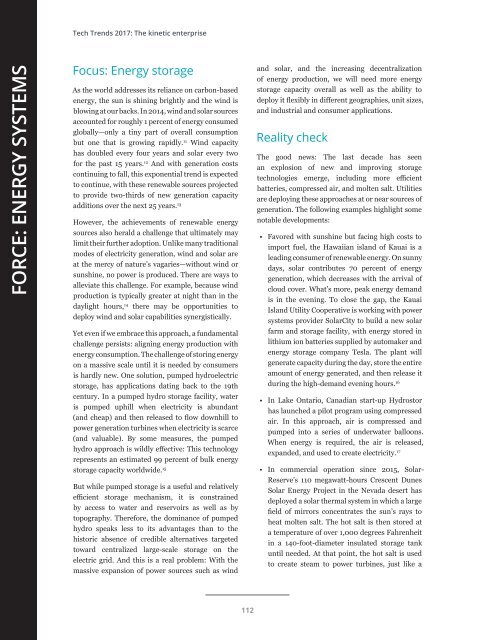Trending the trends Eight years of research
2kcf8xh
2kcf8xh
Create successful ePaper yourself
Turn your PDF publications into a flip-book with our unique Google optimized e-Paper software.
Tech Trends 2017: The kinetic enterprise<br />
FORCE: ENERGY SYSTEMS<br />
Focus: Energy storage<br />
As <strong>the</strong> world addresses its reliance on carbon-based<br />
energy, <strong>the</strong> sun is shining brightly and <strong>the</strong> wind is<br />
blowing at our backs. In 2014, wind and solar sources<br />
accounted for roughly 1 percent <strong>of</strong> energy consumed<br />
globally—only a tiny part <strong>of</strong> overall consumption<br />
but one that is growing rapidly. 11 Wind capacity<br />
has doubled every four <strong>years</strong> and solar every two<br />
for <strong>the</strong> past 15 <strong>years</strong>. 12 And with generation costs<br />
continuing to fall, this exponential trend is expected<br />
to continue, with <strong>the</strong>se renewable sources projected<br />
to provide two-thirds <strong>of</strong> new generation capacity<br />
additions over <strong>the</strong> next 25 <strong>years</strong>. 13<br />
However, <strong>the</strong> achievements <strong>of</strong> renewable energy<br />
sources also herald a challenge that ultimately may<br />
limit <strong>the</strong>ir fur<strong>the</strong>r adoption. Unlike many traditional<br />
modes <strong>of</strong> electricity generation, wind and solar are<br />
at <strong>the</strong> mercy <strong>of</strong> nature’s vagaries—without wind or<br />
sunshine, no power is produced. There are ways to<br />
alleviate this challenge. For example, because wind<br />
production is typically greater at night than in <strong>the</strong><br />
daylight hours, 14 <strong>the</strong>re may be opportunities to<br />
deploy wind and solar capabilities synergistically.<br />
Yet even if we embrace this approach, a fundamental<br />
challenge persists: aligning energy production with<br />
energy consumption. The challenge <strong>of</strong> storing energy<br />
on a massive scale until it is needed by consumers<br />
is hardly new. One solution, pumped hydroelectric<br />
storage, has applications dating back to <strong>the</strong> 19th<br />
century. In a pumped hydro storage facility, water<br />
is pumped uphill when electricity is abundant<br />
(and cheap) and <strong>the</strong>n released to flow downhill to<br />
power generation turbines when electricity is scarce<br />
(and valuable). By some measures, <strong>the</strong> pumped<br />
hydro approach is wildly effective: This technology<br />
represents an estimated 99 percent <strong>of</strong> bulk energy<br />
storage capacity worldwide. 15<br />
But while pumped storage is a useful and relatively<br />
efficient storage mechanism, it is constrained<br />
by access to water and reservoirs as well as by<br />
topography. Therefore, <strong>the</strong> dominance <strong>of</strong> pumped<br />
hydro speaks less to its advantages than to <strong>the</strong><br />
historic absence <strong>of</strong> credible alternatives targeted<br />
toward centralized large-scale storage on <strong>the</strong><br />
electric grid. And this is a real problem: With <strong>the</strong><br />
massive expansion <strong>of</strong> power sources such as wind<br />
and solar, and <strong>the</strong> increasing decentralization<br />
<strong>of</strong> energy production, we will need more energy<br />
storage capacity overall as well as <strong>the</strong> ability to<br />
deploy it flexibly in different geographies, unit sizes,<br />
and industrial and consumer applications.<br />
Reality check<br />
The good news: The last decade has seen<br />
an explosion <strong>of</strong> new and improving storage<br />
technologies emerge, including more efficient<br />
batteries, compressed air, and molten salt. Utilities<br />
are deploying <strong>the</strong>se approaches at or near sources <strong>of</strong><br />
generation. The following examples highlight some<br />
notable developments:<br />
• Favored with sunshine but facing high costs to<br />
import fuel, <strong>the</strong> Hawaiian island <strong>of</strong> Kauai is a<br />
leading consumer <strong>of</strong> renewable energy. On sunny<br />
days, solar contributes 70 percent <strong>of</strong> energy<br />
generation, which decreases with <strong>the</strong> arrival <strong>of</strong><br />
cloud cover. What’s more, peak energy demand<br />
is in <strong>the</strong> evening. To close <strong>the</strong> gap, <strong>the</strong> Kauai<br />
Island Utility Cooperative is working with power<br />
systems provider SolarCity to build a new solar<br />
farm and storage facility, with energy stored in<br />
lithium ion batteries supplied by automaker and<br />
energy storage company Tesla. The plant will<br />
generate capacity during <strong>the</strong> day, store <strong>the</strong> entire<br />
amount <strong>of</strong> energy generated, and <strong>the</strong>n release it<br />
during <strong>the</strong> high-demand evening hours. 16<br />
• In Lake Ontario, Canadian start-up Hydrostor<br />
has launched a pilot program using compressed<br />
air. In this approach, air is compressed and<br />
pumped into a series <strong>of</strong> underwater balloons.<br />
When energy is required, <strong>the</strong> air is released,<br />
expanded, and used to create electricity. 17<br />
• In commercial operation since 2015, Solar-<br />
Reserve’s 110 megawatt-hours Crescent Dunes<br />
Solar Energy Project in <strong>the</strong> Nevada desert has<br />
deployed a solar <strong>the</strong>rmal system in which a large<br />
field <strong>of</strong> mirrors concentrates <strong>the</strong> sun’s rays to<br />
heat molten salt. The hot salt is <strong>the</strong>n stored at<br />
a temperature <strong>of</strong> over 1,000 degrees Fahrenheit<br />
in a 140-foot-diameter insulated storage tank<br />
until needed. At that point, <strong>the</strong> hot salt is used<br />
to create steam to power turbines, just like a<br />
112


